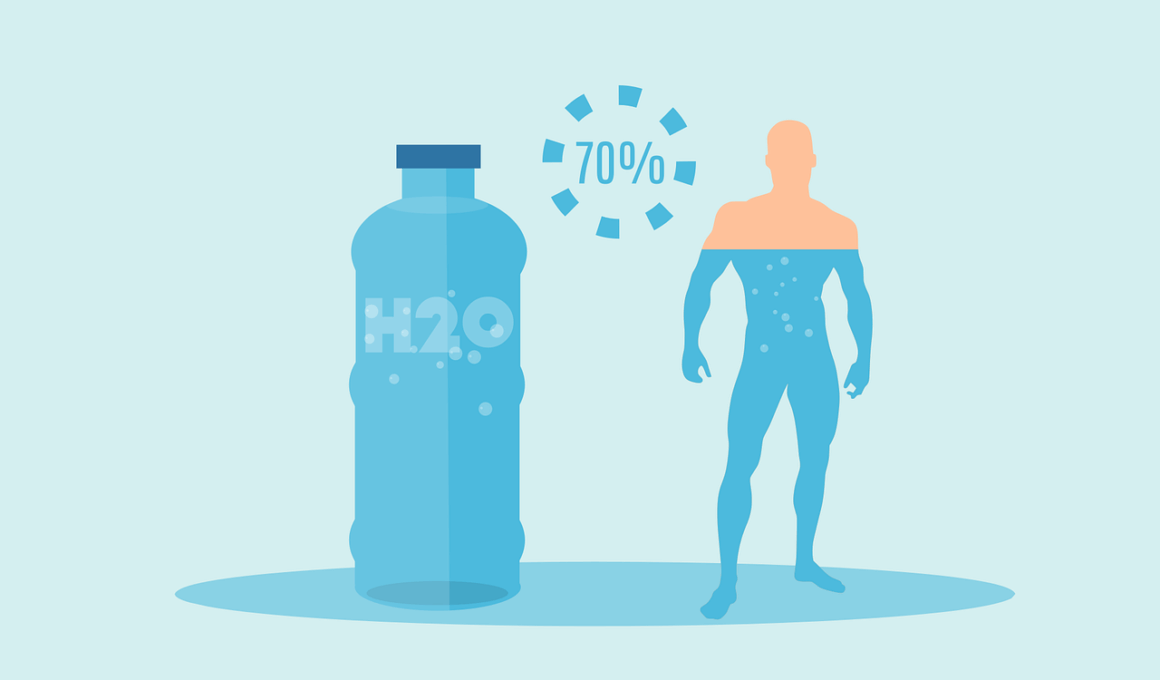Signs of Dehydration Every Golfer Must Recognize
Golfers often spend long hours on the course, and staying hydrated is essential for maintaining peak performance. Dehydration can creep in subtly and affect energy levels, focus, and physical ability. The signs of dehydration vary from mild discomfort to severe consequences. Initially, affected golfers may experience dry mouth, reduced saliva production, and thirst. They might not realize these early signals are cries for hydration. The warm weather and extensive periods of sunlight can exacerbate these symptoms, making it crucial to be proactive. Additionally, dizziness can present itself as hydration decreases, impacting balance and focus on the swing. Muscles may fatigue quicker, potentially leading to poor performance. Cognitive effects may occur, such as decreased attention span or irritation. Body temperature can also rise, leading to heat-related illnesses, especially in hot climates. Therefore, recognizing these early signs and addressing them immediately can prevent severe effects. Making a habit of carrying water, sports drinks, or electrolyte replacements is essential for all golfers to combat the risks of dehydration effectively and enhance overall performance. Take action to ensure health on the course for longer and more enjoyable games.
As the game progresses, golfers may not realize how much fluid they are losing. In addition to recognizing initial signs of dehydration, players must maintain a consistent hydration strategy throughout the game. Regularly consuming small amounts of fluids can prevent dehydration. By prioritizing this habit, golfers can keep energy levels stable and ensure optimal physical performance. Alongside water, sports drinks with electrolytes are highly beneficial; they not only replenish lost fluids but also replace essential salts lost through sweat. Additionally, consuming fruits and vegetables high in water content can contribute to hydration. Options such as watermelon, cucumbers, and oranges can keep golfers feeling hydrated while providing energy. Being aware of the environmental conditions is necessary; hot, sunny days can increase perspiration and fluid loss significantly. Players should consider drinking more fluids on days with high temperatures or humidity. Access to water stations on the course or carrying a refillable bottle is vital. By making hydration a priority, golfers can reduce their chances of experiencing dehydration and ensure a successful game. Aim for a balanced approach between staying hydrated and managing the physical demands of golf for lasting energy and focus during play.
Recognizing Later Signs of Dehydration
As dehydration progresses beyond the initial symptoms, golfers may notice more severe signs indicating significant fluid loss. Players may experience headaches, which can be debilitating and greatly affect concentration on the course. This pain occurs due to the lack of nutrients and hydration making the body less resilient. Additionally, the body may produce darker-colored urine, signaling that it’s under hydrated and needing immediate fluid replenishment. Muscle cramps are another serious sign and can develop quickly, affecting performance and potentially leading to injury. Fatigue will increase, making it increasingly difficult for golfers to maintain endurance over 18 holes. As cognitive function further declines, making critical decisions and tactical moves becomes challenging. Taking breaks for hydration becomes vital in these moments. Golfers must also observe their overall physical condition; feeling unwell could be a precursor to heat exhaustion. Protecting against these later signs is crucial because they can lead to more serious medical issues if not addressed immediately. Therefore, maintaining a vigilant hydration strategy throughout the game is crucial to continued success and well-being on the golf course.
Preventing dehydration doesn’t solely rely on consuming fluids but requires a comprehensive approach that includes pre-game hydration as well. In the days leading up to a round of golf, golfers should prioritize drinking sufficient fluids to prepare their bodies. Ideally, hydration should begin 24 hours before a game to ensure optimal levels are achieved. Furthermore, understanding personal hydration needs can enhance a golfer’s preparation. Each individual’s sweat rate varies, influenced by factors like climate, fitness, and personal health. Players may benefit from consulting with professionals to determine their unique hydration plan tailored to their needs. During the game, drink even when not feeling thirsty because thirst is not always a reliable indicator of hydration demands. To aid performance, incorporate electrolyte supplements as needed, especially during long rounds or hot days. Golfer’s goals include not only finishing holes but also doing so with vigor and mental acuity. Establishing a hydration ritual can create lasting habits well beyond the golf course. Prioritizing fluid intake fosters consistency in performance, enhancing overall success and enjoyment on the course while combating the dangers of dehydration.
Hydration Techniques and Strategies
Implementing various hydration techniques can significantly improve a golfer’s performance. Keeping a water bottle within reach allows for consistent sipping throughout the game. Aim to drink around half of your body weight in ounces of water daily. To add flavor and additional benefits, consider infusing water with fruits, herbs, or electrolytes. Options like lemon, mint, or cucumber not only enhance taste but also encourage sipping throughout the day. Another beneficial strategy is keeping track of fluid intake and adjusting according to environmental conditions. Requesting assistance from friends or fellow golfers can also help maintain accountability for hydration. Designing a simple plan helps avoid unnecessary distractions. Keeping hydration extends beyond drinks; planning meals high in moisture content before and during the game enhances overall hydration. This includes snacks like yogurt, smoothies, or even hydration-focused energy bars. During tournament play, prepare to pack these items for easy access. By adopting these various hydration techniques, golfers can maintain performance and significantly reduce the risks associated with dehydration throughout their rounds. Creating a positive hydration routine enhances every golfer’s experience and contributes to long-term health benefits.
In conclusion, understanding the signs of dehydration and implementing effective hydration strategies is crucial for every golfer. Recognizing symptoms early, from dry mouth to increased fatigue, sets the foundation for an effective response. Reacting promptly by consuming water and electrolyte-rich beverages allows golfers to combat dehydration effectively. Regular hydration plays a vital role in maintaining focus and energy levels on the course, ultimately enhancing overall game quality. Moreover, awareness of progressive signs of dehydration promotes timely action to prevent complications. Consequently, ensuring proper hydration should always be a golfer’s priority, starting days in advance and continuing throughout their play. Establishing consistent hydration methods sets the tone for successful rounds and enjoyable experiences on the course. Motivating other golfers towards better hydration can create a more supportive playing environment that prioritizes health. Ultimately, the pursuit of performance excellence begins with simple, effective actions toward hydration awareness and the implementation of well-thought-out strategies. By committing to prevent dehydration and promote an overall culture of health in golf, players will enjoy more fulfilling experiences and improved game results over time.
Incorporating hydration education into golf training programs may foster better awareness among players. Understanding how water and electrolytes affect overall performance equips golfers with the knowledge needed to optimize their game. Emphasizing hydration’s role in preventing fatigue, cramping, and cognitive decline can ultimately lead to more confidence on the course. In addition, disseminating information through workshops or seminars can establish a broader understanding of the importance of fluid intake. Engaging presentations can highlight real-life examples of hydration success stories or provide testimonials from competitive golfers. Creating easy-to-understand materials like pamphlets or infographics presents invaluable hydration strategies that golfers can adopt. Additionally, promoting research-based recommendations ensures golfers have the latest data on proper hydration practices. Finding new approaches to educate players on hydration strategies can lead to healthier golfing environments and communities. Networking with ambassadors or influential figures in golf who prioritize hydration increases the campaign’s reach. By advocating for hydration awareness, all players can enjoy the benefits of enhanced performance and better health, creating a culture focused on the well-being of every golfer on and off the course.
As golf enthusiasts continue to emphasize hydration as an essential strategy, integrating it into fitness regimens can enhance overall performance. Regular exercise and cardiovascular training can help improve the body’s ability to regulate temperature and stay hydrated efficiently. Engaging in strength training is beneficial too, as it reduces the risk of cramping during games. Also, adapting seasonal drills to build endurance enhances hydration efficiency. Personal fitness plans can benefit from incorporating exercises that specifically boost players’ stamina on the course. Furthermore, individualizing nutrition plans to align with fitness and hydration routines can create greater synergy. Including more whole foods and minimizing processed ones in golfers’ diets can contribute to lasting energy. Striving for a holistic approach towards fitness, nutrition, and hydration fosters a more rewarding golfing experience. The culmination of these elements will lead to improved performance, allowing golfers to finish strong in their rounds. As golfers actively advise one another on hydration and fitness, they can create a supportive environment that encourages personal development both on and off the green, paving the way for future generations to embrace golf with enthusiasm and vitality.


